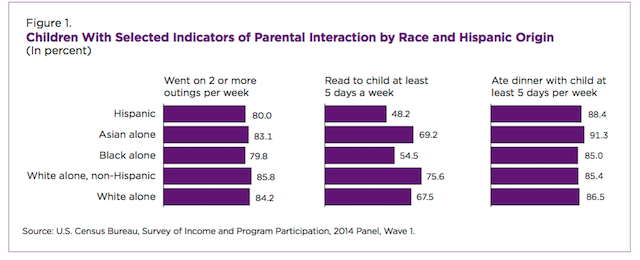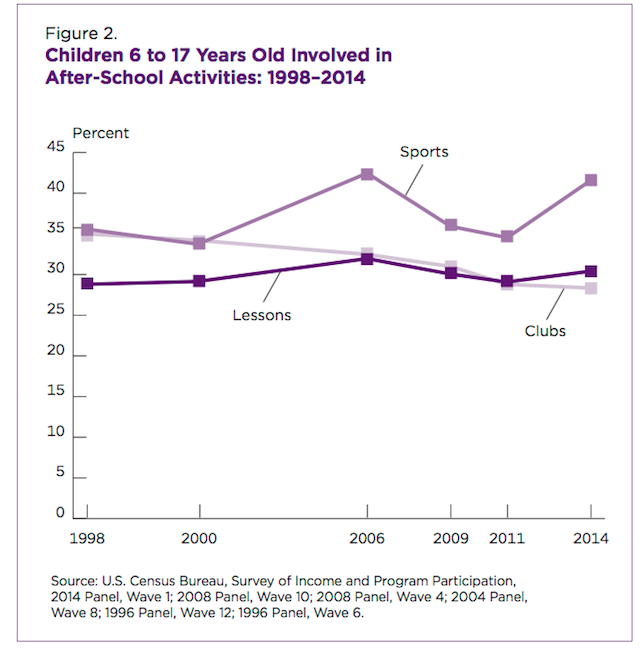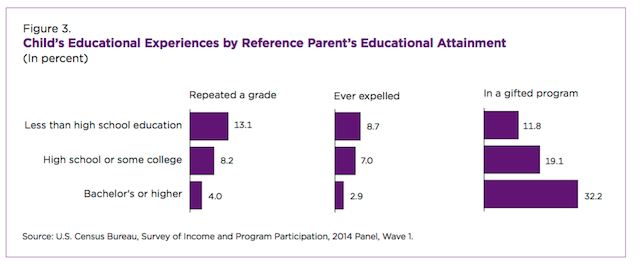Highlights
The U.S. Census Bureau has released a new report highlighting several key indicators of child well-being. The report is based on data from Wave 1 of the 2014 Survey of Income and Program Participation (SIPP). Although the main focus of the SIPP is to collect information on labor force participation, household income, and participation in federal assistance programs, it also collects information from parents on family structure, parent-child interaction, children's school engagement and achievement, and children's involvement in extra-curricular activities, including religious activities.
The report starts with basic information about the characteristics of children's families, which is one of the best indicators of child well-being. The majority of children lived in two-parent families in 2014—most in married-parent families (61%), while 5% lived with two unmarried parents. Overall, 25% of children lived in mother-only families, while 5% lived in father-only families, and 3% lived in families where neither parent is present, such as with grandparents.
Most children (nearly 60%) also lived with one or more biological/adopted siblings but no half/step siblings; about 11% with only half/step siblings; 8% with siblings who are adopted/biological and half/step; and 22% without any siblings. Moreover, 23% of children lived in families with incomes below the poverty threshold.
Here are five additional findings from the report that are noteworthy.
1. Most parents are highly engaged with their children. The report measures "parental interaction" by looking at three questions from the SIPP: how often parents and children eat dinner together, how often parents take their children on outings, and how often parents read to their children. A majority of parents of all races say they go on outings with their kids at least twice a week (about 80%) and eat dinner together as a family most evenings. When it comes to reading, there is a wider gap by race: with 54.5% of Black parents reading to their children at least 5 days a week versus 75.6 % of White non-Hispanic parents. At least 85% of children of every race and Hispanic origin eat dinner with their families at least five days a week, which is great news since frequent family dining is linked to a wide range of protective factors for children and adolescents.

2. Children are as involved in extracurricular activities as they were 15 years ago. With all the concern over children spending too much time with screens, it is encouraging to learn that (as of 2014, at least) kids are more involved in sports than they were in the previous decade. For example, the percentage of school-aged children who participated in sports increased from 36% to 42% between 1998 and 2014. While the percentage of children involved in school clubs has declined, student involvement in extracurricular lessons has fluctuated over the years to be about the same in 2014. At the same time, children in lower-income families are less likely to be involved in all three extracurricular activities: for example, 24% of children in poverty participated in sports, compared to 57% of children in higher-income families.

3. Unfortunately, children’s monthly participation in religious activities has declined, dropping from 65% in 2006 to 54% in 2014. The report points out the decline is “consistent with research showing that children today participate less frequently in religious activities than previous cohorts.” That’s bad news for children in light of research linking religious involvement in childhood to better mental, emotional, and physical health for adolescents and young adults.
4. Children's school performance is closely related to their parents' education level. The SIPP asks parents if their child has ever been expelled, repeated a grade, or participated in a gifted program. As the figure below indicates, children of higher-educated parents perform better on all three questions than students with less-educated parents.

Although this report does not compare students by their parents' marital status for school achievement, a large body of research shows that students in married-parent families generally perform better in school than those who are raised in other family forms.
5. Children’s engagement in school is associated with parents' education and marital status, as well as with being more involved in extracurricular activities. The SIPP also asks parents “the extent to which the child did schoolwork only when forced to, did just enough schoolwork to get by, always did homework, and cared about doing well in school.” Of the 49 million children enrolled in school, 35% are highly engaged, with girls (42%) being more so than boys (29%). Black students (36%) and White students (35%) were about the same, and Asian children were the most likely of all racial groups to be highly engaged in their studies (49%).
Characteristics related to family structure, parental education, and student involvement in extracurricular activities were all linked to better school engagement. For example, 37% of children with married parents were highly engaged, versus 30% of children with never-married parents. Similar to school achievement, children of higher-educated parents were also more engaged in school: 40% of children with a college-educated parent were highly engaged, compared to 33% of children with lesser-educated parents.
Finally, students were more likely to be engaged in school when they also played a sport, joined a club, or had educational lessons outside the classroom. School engagement was also positively associated with being involved in more than one extracurricular activity.
Alysse ElHage is Editor of the Institute for Family Studies blog.














